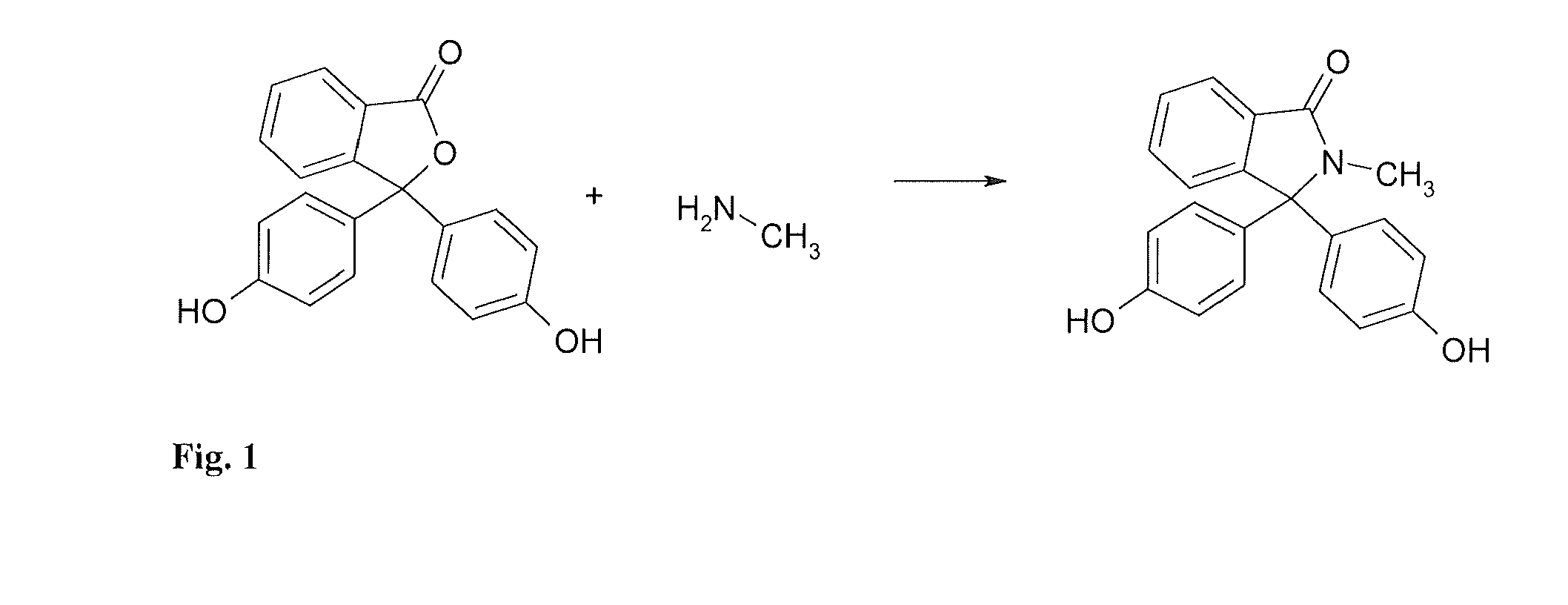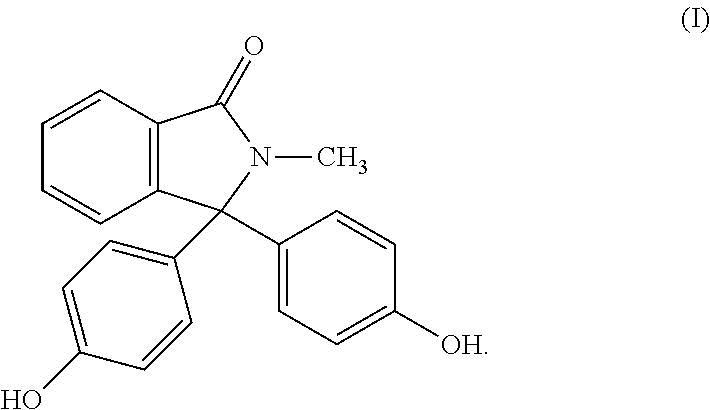Polycarbonate having improved thermal and mechanical properties and reduced coefficients of thermal expansion
a polycarbonate and thermal expansion coefficient technology, applied in the direction of organic chemistry, transportation and packaging, synthetic resin layered products, etc., can solve the problems of high cost of amorphous high-tg thermoplastics in some cases, mechanical properties of constant thermal expansion of amorphous polycarbonate with constant thermal properties, and the coefficient of linear thermal expansion remain unconsidered
- Summary
- Abstract
- Description
- Claims
- Application Information
AI Technical Summary
Benefits of technology
Problems solved by technology
Method used
Image
Examples
example 1
[0157]The synthesis of the monomer building block according to the invention is effected according to FIG. 1.
[0158]A solution of 2 kg (20.2 mol) of N-methylpyrrolidone (NMP) and 1273.3 g (4 mol) of phenolphthalein is initially introduced into a reactor having a plane ground joint. With stirring, 2 litres of water and then 18 mol of a 40% strength aqueous methylamine solution are added. On addition of the methylamine, the reaction solution acquires a violet discoloration. With the use of a dry ice cooler, stirring is then continued for 8 hours at 82° C. The colour of the reaction batch changes to dark yellowish. After the end of the reaction, the reaction batch is precipitated by means of a dropping funnel with stirring in a vessel of water containing hydrochloric acid.
[0159]The precipitated white reaction product is suspended with 2 litres of water and then filtered with suction by means of a G3 frit. The crude product obtained is dissolved again in 3.5 litres of a dilute sodium hyd...
example 2
Synthesis of the Copolycarbonate According to the Invention
[0167]11.79 litres of methylene chloride and 14.1 litres of chlorobenzene are added to a solution made inert with nitrogen and comprising 532.01 g (1.6055 mol) of bisphenol A (BPA), 2601.36 g (11.39 mol) of bisphenol, from example 1, 93.74 g (0.624 mol, 4.8 mol %, based on diphenols) of p-tert.-butylphenol (BUP) as a chain terminator and 1196 g (29.9 mol) of sodium hydroxide in 25.9 litres of water. At a pH of 12.5-13.5 and 20° C., 2.057 kg (20.8 mol) of phosgene are passed in. In order to prevent the pH from falling below 12.5, 30% strength sodium hydroxide solution was added during the phosgenation. After the end of the phosgenation and flashing with nitrogen, stirring is effected for 30 minutes and 14.7 g (0.13 mol, 1 mol %, based on diphenols) of N-ethylpiperidine are then added as a catalyst and stirring is continued for 1 hour. After removal of the aqueous phase and acidification with phosphoric acid by means of a sepa...
examples 3 to 5
Further Synthesis Examples for Copolycarbonates According to the Invention
[0168]The copolycarbonates of Examples 3 to 5 were prepared analogously to Example 2 (for results, see Table 1).
TABLE 1CopolycarbonatecomprisingExample 5Example 4Example 3Example 2Bisphenol fromExample 1[mol %]55.525.018.012.4[% by weight]62.232.624.217.0Bisphenol A (BPA)[mol %]44.5758287.6[% by weight]37.867.475.883Vicat temperature [° C.]228.2188.3177.4168.6Glass transition230.0189.9178.9168.7temperature Tg [° C.]ηrel1.2351.2401.2371.238
Apec® samples (Bayer MaterialScience AG, Germany) having the Vicat temperatures stated in Table 2 are used as comparative samples. These represent the closest prior art for polycarbonates in high temperature applications.
TABLE 2Comparative examples6789Vicat temperature158173183203[° C.]Glass transition157.2169.9179.3204temperature Tg [° C.]Coefficient of68.068.066.066.0expansionTransverse [10−6 / K]Coefficient of67.067.067.064.0expansionLongitudinal [10−6 / K]Sample according to2...
PUM
| Property | Measurement | Unit |
|---|---|---|
| mol % | aaaaa | aaaaa |
| mol % | aaaaa | aaaaa |
| mol % | aaaaa | aaaaa |
Abstract
Description
Claims
Application Information
 Login to View More
Login to View More - R&D
- Intellectual Property
- Life Sciences
- Materials
- Tech Scout
- Unparalleled Data Quality
- Higher Quality Content
- 60% Fewer Hallucinations
Browse by: Latest US Patents, China's latest patents, Technical Efficacy Thesaurus, Application Domain, Technology Topic, Popular Technical Reports.
© 2025 PatSnap. All rights reserved.Legal|Privacy policy|Modern Slavery Act Transparency Statement|Sitemap|About US| Contact US: help@patsnap.com



